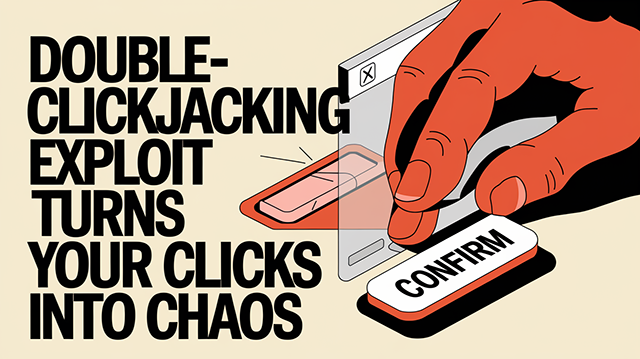DoubleClickjacking Exploit Turns Your Clicks into Chaos

Threat Group: Unattributed
Threat Type: Clickjacking Variant
Exploited Vulnerabilities: User Interface (UI) Redressing Vulnerabilities
Malware Used: None
Threat Score: High (8.0/10) – Due to its ability to bypass existing clickjacking defenses and exploit common user interactions.
Last Threat Observation: January 3, 2025
Overview
DoubleClickjacking is an advanced form of clickjacking that manipulates users into performing unintended actions by exploiting double-click sequences. Unlike traditional clickjacking, which typically involves a single click to deceive users, DoubleClickjacking leverages the rapid succession of two clicks to bypass security measures and execute unauthorized commands. This method often employs transparent iframes and swift content replacements to mask malicious elements, making detection and prevention more challenging.
The attack operates by presenting a seemingly legitimate interface that prompts the user to double-click a specific element. The first click interacts with a benign component, while the second click, occurring within milliseconds, is redirected to a concealed malicious target. This technique capitalizes on the brief interval between clicks, during which the attacker's content is swiftly loaded and executed without the user's awareness. As a result, users may inadvertently authorize transactions, change settings, or disclose sensitive information, all while believing they are engaging with a trustworthy application.
Key Details
- Delivery Method: Malicious web pages employing transparent iframes and rapid content swapping techniques.
- Target: General internet users across various platforms and browsers, including Chrome, Edge, and Safari.
- Functions:
- Bypasses traditional clickjacking defenses.
- Exploits double-click sequences to perform unauthorized actions.
- Manipulates user interface elements to deceive users.
- Potentially grants attackers unauthorized access to user accounts.
- Operates without the need for malware installation.
- Obfuscation: Utilizes transparent iframes and rapid content swapping to conceal malicious actions.
Attack Vectors
DoubleClickjacking attacks typically involve the following steps:
- Deceptive Interface Presentation: Attackers create a malicious webpage that appears legitimate, enticing users to interact with it.
- Transparent Overlay Implementation: A transparent iframe containing a sensitive action (e.g., authorizing an account change) is placed over a seemingly innocuous button or link.
- Double-Click Exploitation: The user is prompted to double-click a button. The first click removes the visible element, exposing the underlying iframe, while the second click unknowingly authorizes the unintended action.
- Action Execution: The unauthorized action is executed, such as changing account settings or initiating a transaction, without the user's informed consent.
Known Indicators of Compromise (IoCs)
As DoubleClickjacking does not involve malware installation, traditional IoCs like file hashes or malicious domains are not applicable. Detection relies on monitoring for unusual user behaviors and implementing advanced UI integrity checks.
Mitigation and Prevention
- User Awareness: Educate users about the risks of double-clicking on unfamiliar web pages and encourage vigilance when prompted for double-click actions.
- UI Interaction Delays: Implement slight delays for critical actions following a double-click to allow time for detecting and preventing unauthorized operations.
- Frame Busting Techniques: Employ JavaScript-based frame-busting methods to prevent your website from being embedded within iframes on unauthorized domains.
- Content Security Policy (CSP): Configure the
frame-ancestorsdirective in CSP headers to control which sources are permitted to frame your content, thereby mitigating clickjacking risks. - Regular Security Audits: Conduct frequent security assessments to identify and address potential vulnerabilities related to UI redressing attacks.
Risk Assessment
DoubleClickjacking represents a significant evolution in clickjacking techniques, effectively bypassing established defenses and exploiting common user behaviors. The attack's sophistication and its potential to cause unauthorized actions without user awareness elevate its threat level, necessitating immediate attention and remediation efforts from cybersecurity professionals.
Conclusion
The emergence of DoubleClickjacking underscores the need for continuous advancements in web security measures and user education. Organizations should promptly implement the recommended mitigation strategies and maintain a proactive approach to security to safeguard against this and similar threats.
Sources:
- BleepingComputer - New DoubleClickjacking attack exploits double-clicks to hijack accounts - https://www.bleepingcomputer.com/news/security/new-doubleclickjacking-attack-exploits-double-clicks-to-hijack-accounts/
- Infosecurity Magazine - New DoubleClickjacking Attack Bypasses Protections - https://www.infosecurity-magazine.com/news/doubleclickjacking-attack-bypasses/
- Forbes - Don’t Click Twice—New Chrome, Edge, Safari Hack Attack Warning - https://www.forbes.com/sites/daveywinder/2025/01/03/dont-click-twice-new-chrome-edge-safari-hack-attack-warning/
- Cybernews - Double-clickjacking: attackers can steal user accounts unnoticed - https://cybernews.com/security/double-clickjacking-attackers-can-steal-user-accounts/


